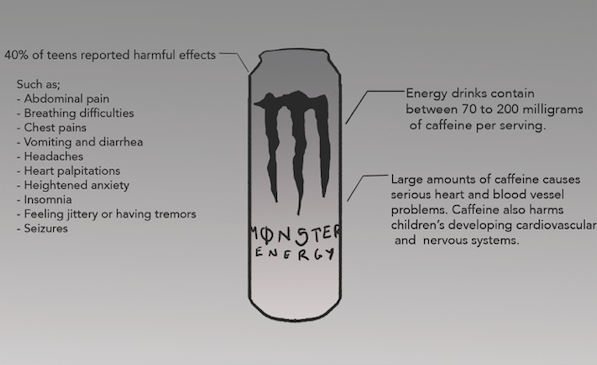
Written by Yessica Banda, Staff Writer

Since Monster and Red Bull first appeared on store shelves in the early 2000s, the consumption of highly caffeinated energy drinks has increased significantly in America with no signs of stopping.
Consumption will increase by $84.8 billion by 2025, states Grand View Research, a U.S.-based market research and consulting company headquartered in San Francisco.
And teens are projected to make up a growing share of the energy drink market.
“High schoolers are continuously feeling more pressure to take on more rigorous coursework, causing a loss of sleep, causing them to turn towards energy drinks to make them feel energized when they didn’t get a lot of sleep,” said James Oscar, an Indian Trail High School senior in the Medical Science Academy.
Teen customers battle the drinks boost performance and help them be more conscious of their surroundings, noting the main ingredient in these energy drinks is caffeine.
“More and more people are relying on highly-caffeinated products to get through the day when really they need to be focusing on giving their bodies the proper things that they need to function, mainly adequate sleep and nutrition,” said Alex Jensen, another Med-Sci senior.
Others turn to these products just for the flavor.
“There are new companies coming out with energy drinks that target teens with their fruity flavors,” said Brenda Murguia, a Communications Academy senior.
“They don’t drink it for the energy, but for the flavor,” Murguia said.
But public health researchers are sounding the alarm about overuse of the product. According to a 2019 study by researchers at the Harvard School of Public Health in
Boston, Mass., teens who consume energy drinks are more at risk for developing depression and substance abuse than teens who never drink energy drinks.
Although moderate caffeine intake — up to 100 milligrams a day for teens — is considered safe, higher volumes may increase the possibility that individuals will engage in risk-seeking behaviors, experience mental health strains like increased depression, or adverse cardiovascular effects like increased blood pressure. Added sugar in many of the energy drinks may also increase the risk of obesity, type 2 diabetes, and dental problems. Mixing energy drinks with alcohol, which is growing in popularity among young adults, can lead to overconsumption of alcohol and incidence of alcohol-related such as crashes, researchers reported.
Students here at Indian Trail expressed how these products made them feel groggy, loopy, and crash during the day. Other symptoms include abdominal pain, breathing difficulties, chest pains, gastrointestinal problems, headaches, heart palpitations, heightened anxiety, insomnia, feeling jittery, and seizures.
“They have a lot of unnecessary chemicals in them and can really take a toll on overall bodily function if consumed very frequently, so I feel like overall they’re unhealthy, but then again everything is unhealthy if consumed too much,” said Jensen.
Despite concerns raised by health officials, teens argue against the government putting restrictions on the purchase of energy drinks.
A random survey of 20 Indian Trail students asked what age consumers should be al- lowed to purchase energy drinks. The overwhelming majority chose age 16.
“If soda is allowed, then I don’t see why energy drinks shouldn’t be,” said Jensen, who responded that 16 was an appropriate age.
“Since you are allowed to get your license at 16, I feel that the government begins to see a sense of responsibility in teenagers around that age,” said Janet Jurado, a General Studies senior.
